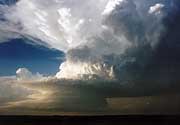Thunderstorms
NSSL scientists have a long history of studying some of the most challenging and threatening weather events. Understanding thunderstorms - their lifecycle, basic structure and evolution - leads them to a clearer understanding of the hazards that come from them.
Tornadoes
They understand pretty well the kind of thunderstom that spawns tornadoes - the supercell thunderstorm. Although they have learned a lot about tornadoes through theoretical studies, field projects, physical models and computer modeling, scientists still don't know the exact cause of tornado formation.
Floods
Flash floods are especially dangerous because they occur with little or no warning. They are the number one weather-related killer in the U.S.
Hail
Damage from hailstorms causes economic imacts and sometimes serious injuries or fatalities. Differing thunderstorm conditions cause wet or dry hail to form. Scientists are thinking about new ways to explain hail formation.
Lightning
The exact mechanism by which a cloud builds up electrical charges leading to lightning is not fully understood, but studies at NSSL are giving scientists a clearer picture of the process.
Winter Weather
Special atmospheric conditions and small variations in temperature determine whether precipitation will fall as snow, freezing rain, or sleet.
Damaging winds
Straight-line winds often mimic tornadoes by causing widespread damage and occasional fatalities. Strong thunderstorm winds can be caused by a number of different processes.

